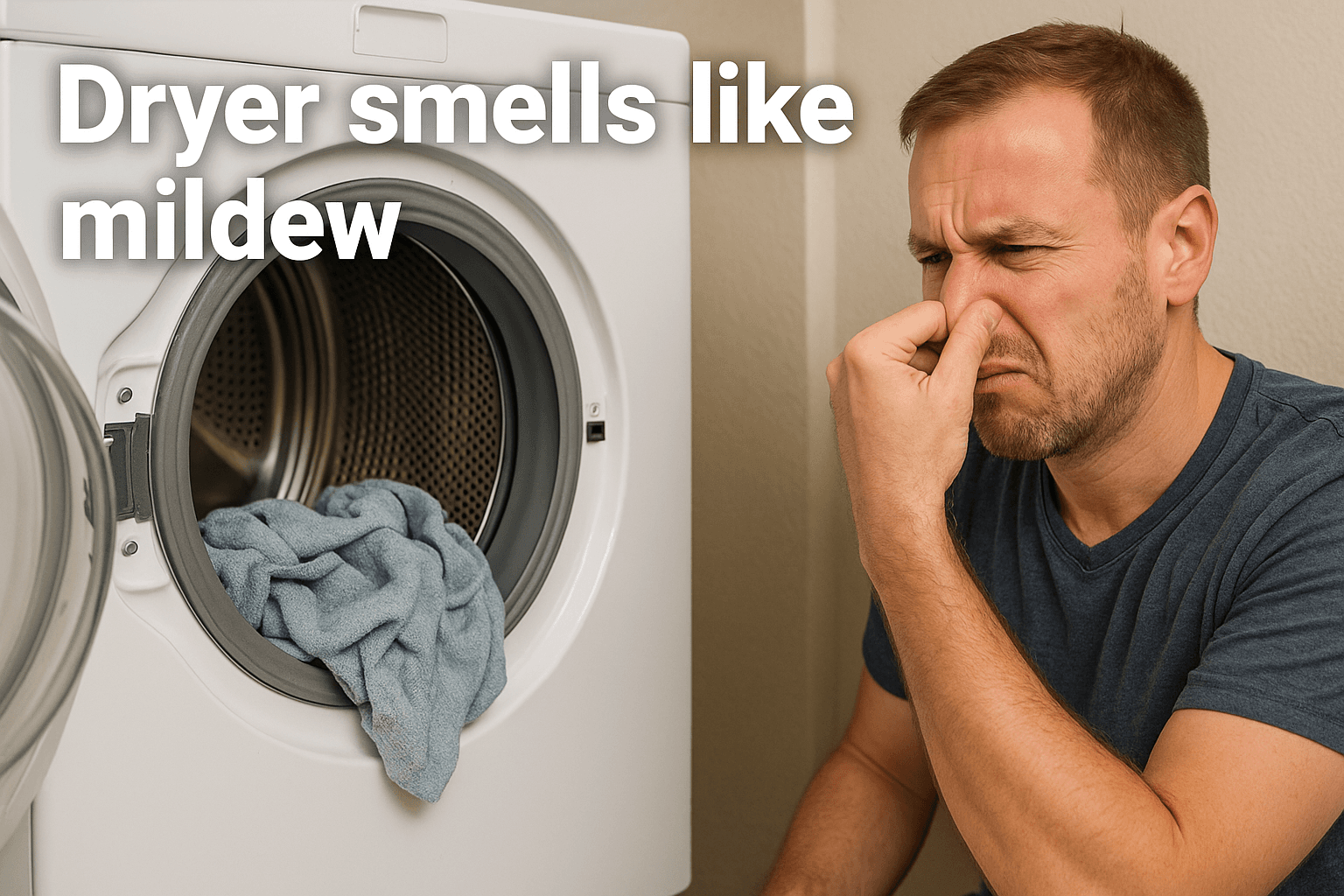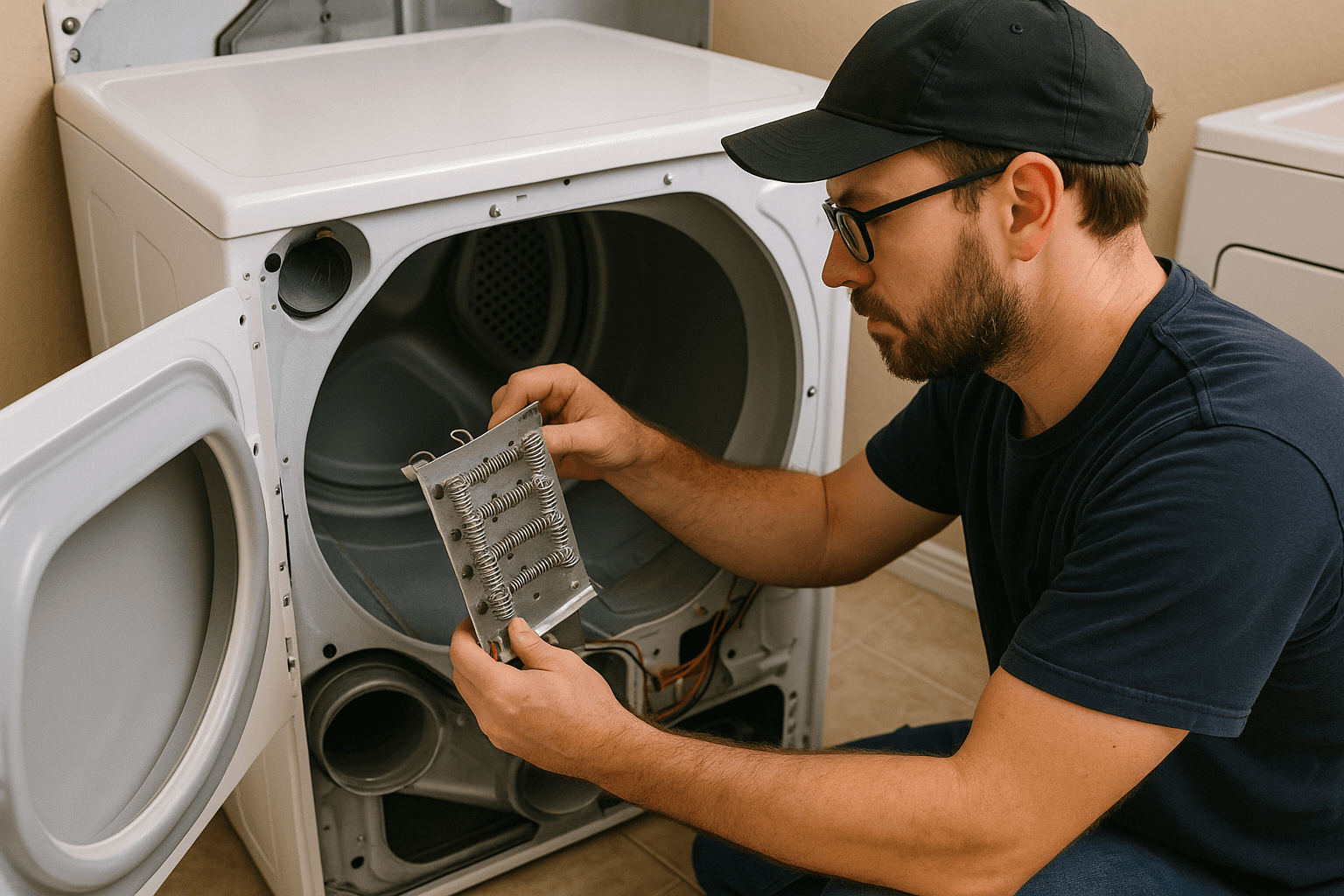Review
What is a Dryer Thermal Fuse? How Does It Work?
AZparts Team
Updated on October 10, 2025
9 min read
If your dryer suddenly stops working, a blown thermal fuse might be the reason. But what is a dryer thermal fuse, and why does it matter? This small component plays a big role in protecting your dryer from overheating. In this article, AZParts’ll explain how it works and reveal 7 signs that your thermal fuse may have failed.
_1747894843.jpg&w=3840&q=75)
1. What is a Dryer Thermal Fuse?
A dryer thermal fuse is a safety device that protects your dryer from overheating. It monitors the internal temperature and will cut power to the heating element if heat levels get too high. This helps prevent fires and damage to internal components. The fuse is usually located near the blower housing or dryer heating element, depending on the model.
When the thermal fuse blows, the dryer may stop heating or stop running entirely. Unlike a resettable switch, the fuse must be replaced after it trips. A blown fuse often indicates a bigger issue, such as a clogged vent or restricted airflow. Fixing the root cause is essential before installing a new fuse to restore safe dryer operation.
A dryer thermal fuse is a safety device that protects your dryer from overheating (Source: AZParts)
2. What’s the purpose of a thermal fuse?
The dryer thermal fuse may be small, but it plays a critical role in keeping your dryer safe and reliable. Acting as a built-in safety barrier, it prevents dangerous overheating that could lead to serious hazards. Understanding what is a thermal fuse helps homeowners recognize why regular inspection and maintenance of this part are essential for both appliance longevity and household safety.
Fire Prevention
One of the most important functions of the dryer fuse is protecting your home from potential fires. This safety device quickly reacts when the dryer’s internal temperature rises beyond safe limits.
- Instant Response: The dryer thermal fuse immediately cuts power to the heating element when abnormal heat levels are detected, stopping the temperature from climbing further.
- Stops Overheating: By disconnecting power early, the fuse prevents the dryer from reaching ignition-level temperatures.
- Reduces Lint Fire Risks: Since lint buildup is highly flammable, the fuse’s quick action helps keep lint from catching fire during operation.
Component Protection
In addition to preventing fires, a functioning dryer thermal fuse also safeguards the dryer’s internal parts. Excessive heat can damage sensitive electronics, motors, and wiring. By interrupting power flow under extreme heat, the dryer fuse helps preserve these components, extending the overall dryer lifespan of your appliance and preventing costly repairs.
When the temperature inside the dryer becomes too high, the fuse automatically cuts power to the heating element (Source: AZParts)
3. Advantages of Having a Properly Working Thermal Fuse
A properly working dryer thermal fuse is essential for both the performance and safety of your appliance. This small but critical component does more than just protect the dryer — it helps ensure safer, more efficient, and cost-effective laundry care. Understanding what is a thermal fuse and why it matters allows homeowners to appreciate the importance of regular maintenance and timely replacement of this part.
Safety
One of the biggest benefits of maintaining a healthy dryer fuse is improved home safety. Acting as a safeguard against overheating, the dryer thermal fuse automatically cuts power to the heating element when excessive temperatures are detected.
Preventing Overheating
By interrupting power before the dryer reaches dangerous heat levels, the fuse effectively prevents potential fire hazards and protects other internal components from damage. Regularly checking and replacing the dryer fuse helps your appliance run reliably while reducing the risk of costly repairs or safety issues.
A thermal fuse reduces the risk of fire and ensures safer operation during every cycle (Source: AZParts)
4. 7 Signs that Dryer’s Thermal Fuse Has Blown
A blown thermal fuse can cause your dryer to stop functioning and may indicate underlying electrical problems within your home. In many cases, a bad thermal fuse dryer not only disrupts your laundry routine but also warns of airflow or heating issues that need attention. Identifying the root cause behind a blown thermal fuse helps you prevent recurring failures, protect your appliance, and maintain safe operation. Below are seven common signs and contributing factors that may point to a faulty or bad thermal fuse dryer.
Short Circuit
A short circuit can cause the thermal fuse to blow instantly. When hot and neutral wires make unintended contact, they create a sudden surge of electricity. This surge generates excess heat, which triggers the fuse to shut off power as a safety measure. If your dryer stops working abruptly, a short circuit could be the cause.
A short circuit can cause the thermal fuse to blow instantly (Source: AZParts)
Ground Fault
A ground fault happens when electricity flows through an unintended path, often due to moisture or damaged insulation. This situation creates a dangerous imbalance in the electrical current. The thermal fuse responds by cutting power to prevent further damage. If your dryer keeps shutting down, check for grounding issues inside the appliance or power cord.
If your dryer keeps shutting down, let’s check for grounding issues inside the appliance (Source: AZParts)
Damaged Electrical Outlets
Faulty or burned outlets can deliver inconsistent voltage to your dryer. This instability puts extra stress on the internal components and causes the thermal fuse to react. If you see signs of blackened outlet surfaces or smell burning near the plug, the outlet may be at fault. Replacing or repairing the outlet is crucial to avoid repeated fuse failures.
If the outlet surface is black or there is a burning smell near the plug, then there is definitely a problem with the outlet (Source: AZParts)
Damaged Wires
Exposed or frayed wires within the dryer or wall socket can lead to overheating and electrical arcing. These conditions affect the power supply and force the thermal fuse to break the circuit. Inspecting wires for physical wear is essential if your dryer stops mid-cycle. Replacing damaged wiring helps restore safe and consistent performance.
Exposed or frayed wires affect the power supply and force the thermal fuse to break the circuit (Source: AZParts)
Overloaded Circuit
Plugging too many appliances into the same circuit can lead to overload. When the electrical load exceeds what the circuit can handle, it generates excess heat. This heat can travel to the dryer and activate the thermal fuse. If your dryer shares a circuit with other large appliances, consider moving it to a dedicated outlet.
Consider moving it to a dedicated outlet if your dryer shares a circuit with other large appliances (Source: AZParts)
Wrong Fuse Type
Using a fuse that does not match your dryer’s voltage or amperage rating can lead to premature failure. A fuse that is too weak may blow under normal operation. On the other hand, a fuse that is too strong may not respond to dangerous temperatures. Always check your dryer’s specifications before replacing the thermal fuse.
Aging or Outdated Electrical System
Old wiring or outdated breaker panels may not manage modern electrical loads efficiently. These systems are more prone to power surges, voltage drops, and grounding issues. As a result, the thermal fuse may blow repeatedly to compensate for these electrical irregularities. Upgrading your home’s electrical system can protect both your dryer and other appliances.
Old or outdated electrical systems can cause thermal fuses to blow repeatedly (Source: AZParts)
5. How to Protect the Dryer Thermal Fuse?
The thermal fuse is a vital safety feature that protects your dryer from overheating. To keep this component functioning properly, you need to maintain your dryer regularly and ensure airflow remains unrestricted. Simple maintenance habits can extend the life of the fuse and prevent unexpected breakdowns.
Clean Lint Traps
The lint trap collects loose fibers and debris from your laundry. If you do not clean the trap regularly, lint can accumulate and restrict airflow. Poor airflow increases internal heat, which puts the thermal fuse at risk. Cleaning the lint trap after every load helps maintain proper ventilation and reduces overheating inside the dryer.
Inspect Venting
The venting system directs hot air out of the dryer to prevent internal heat buildup. Over time, lint and dust can clog the vent hose or the wall duct. This blockage causes heat to stay trapped inside the unit, which may trigger the thermal fuse. You should inspect the entire vent path every few months to ensure it is clear and functioning properly.
You should inspect the entire vent path every few months (Source: AZParts)
Regular Servicing
Routine maintenance by a qualified technician can detect early signs of mechanical or dryer issues. A professional can clean hidden components, tighten connections, and confirm the system is running at a safe temperature. Regular servicing not only protects the thermal fuse but also improves the dryer’s efficiency and extends its overall lifespan.
Understanding what is a dryer thermal fuse helps you act quickly when your dryer malfunctions. Recognizing the signs of a blown fuse can save you from further damage and costly repairs. When it's time to replace the dryer fuse, trust AZParts for high-quality thermal fuses and other essential dryer parts. We stock parts for a wide range of brands like Electrolux parts, Samsung, Kenmore, Bosch, etc. and offer fast delivery to get your appliance back up and running.
6. FAQ about Dryer Thermal Fuse
Will a dryer work without a thermal fuse?
No, a dryer will not work without a thermal fuse. This fuse is a critical safety device that prevents the appliance from overheating. When it’s blown or removed, most dryers automatically stop operating to avoid potential fire hazards. If your dryer isn’t turning on, a blown thermal fuse or bad thermal fuse dryer is often the cause and should be replaced before using the appliance again.
How much does it cost to replace a thermal fuse on a dryer?
Replacing a dryer thermal fuse is usually affordable. The part itself typically costs between $5 and $30, depending on your dryer brand and model. If you hire a technician, total repair costs — including labor — may range from $80 to $150. It’s a small price for restoring safety and ensuring your dryer runs properly.
Can you fix a dryer thermal fuse?
No, a thermal fuse cannot be repaired once it’s blown. It’s a one-time safety device designed to break the circuit permanently when overheating occurs. The only safe and effective solution is to replace the blown thermal fuse with a new one. However, it’s equally important to find out why the fuse blew — such as a clogged vent, poor airflow, or overheating issue — to prevent it from happening again.
Contact information:
8 The Green, Ste A, Dover, Delaware 19901-3618, United States
Read more:
Dryer
Further Reading
Further Reading





